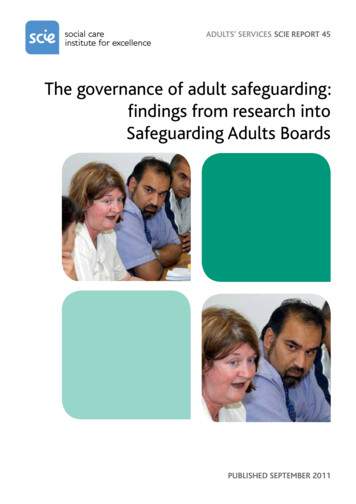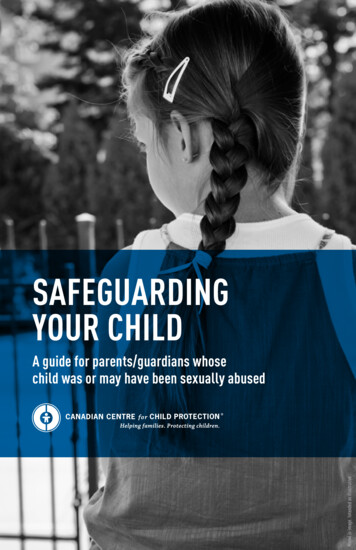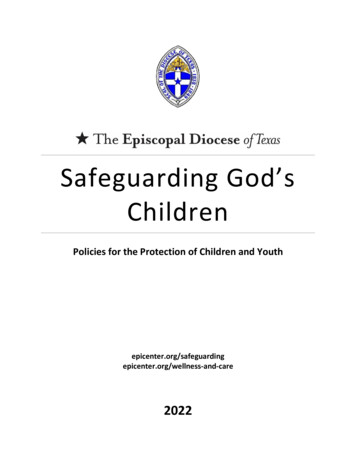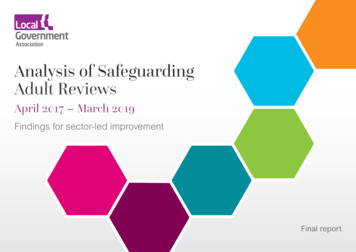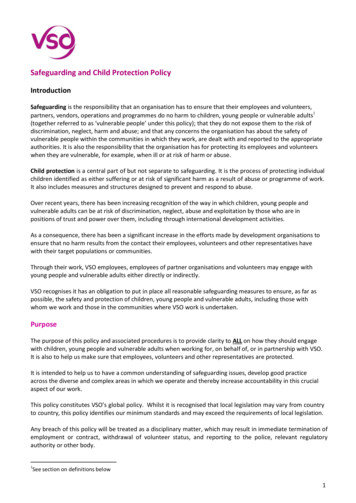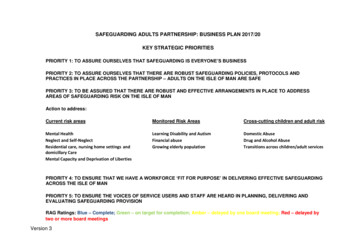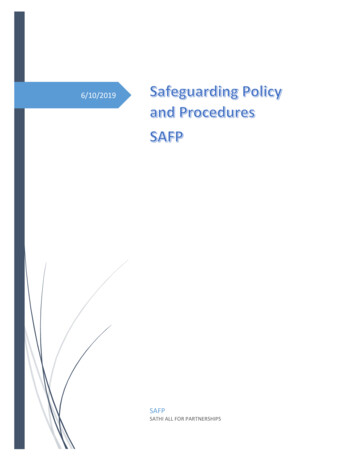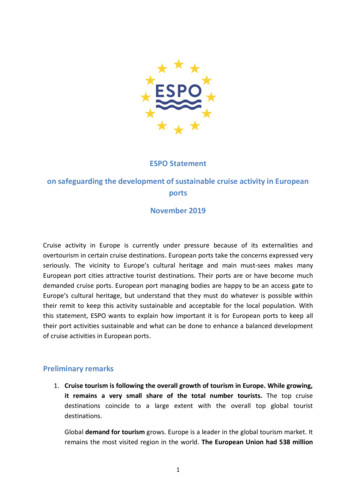
Transcription
ESPO Statementon safeguarding the development of sustainable cruise activity in EuropeanportsNovember 2019Cruise activity in Europe is currently under pressure because of its externalities andovertourism in certain cruise destinations. European ports take the concerns expressed veryseriously. The vicinity to Europe’s cultural heritage and main must-sees makes manyEuropean port cities attractive tourist destinations. Their ports are or have become muchdemanded cruise ports. European port managing bodies are happy to be an access gate toEurope’s cultural heritage, but understand that they must do whatever is possible withintheir remit to keep this activity sustainable and acceptable for the local population. Withthis statement, ESPO wants to explain how important it is for European ports to keep alltheir port activities sustainable and what can be done to enhance a balanced developmentof cruise activities in European ports.Preliminary remarks1. Cruise tourism is following the overall growth of tourism in Europe. While growing,it remains a very small share of the total number tourists. The top cruisedestinations coincide to a large extent with the overall top global touristdestinations.Global demand for tourism grows. Europe is a leader in the global tourism market. Itremains the most visited region in the world. The European Union had 538 million1
international tourist arrivals in 2017, accounting for 40% of global internationaltourist arrivals.1Europe is the world’s second most popular cruise destination, second only to theCaribbean. 6.50 million passengers embarked on cruises from European ports in2017.22. The prime driver of cruise business is the destination. The development of thecruise port business in a port is only partially in the hands of the port authority. Thechanging attractiveness or new branding of a tourist destination can suddenly turn aport into a must as cruise destination. Equally, changing geopolitical situations or anyevent or circumstance that makes a tourist destination less popular will affect thecruise port, whatever the quality of service or facilities it proposes.3. European cruise ports are very diverse. They serve different market segments andcan have diverse roles (e.g. home versus transit ports). Some cruise ports aresituated in cities that are at the same time top touristic destinations, while othersare situated in port cities, which are not a “must-see” destination and consequentlyonly have a limited amount of tourists. In some European ports the cruisebusiness/industry is the main port activity, in other ports the freight functionprevails. Some cruise terminals are located in or very near to the city centre, in otherports the cruise terminal and/or port is situated at a distance from housing areas.4. The cruise industry contributes significantly to the European economy. In 2017, 4.23 billion was spent by cruise passengers and crews in Europe. Passengerexpenditures include spending for shore excursions, pre- and post-cruise hotel stays,air travel and other merchandise at ports-of-embarkation and ports-of-call. Crewspending was concentrated in expenditures for retail goods and food andbeverages.35. 91% of European ports are located in or very close to urban areas. This makesEuropean ports interesting cruise destinations for tourists wanting to discover therich cultural heritage of Europe. It equally increases the pressure on European portsto do as much as possible to limit the pollution and externalities of the activity in andaround the ports, whether it is the responsibility of the port or not.6. In 2014, ESPO signed a strategic cooperation agreement with different regional andnational organisations representing cruise ports: Cruise Baltic, Cruise Europe, Cruise1European Union Tourism Trends, April 2018, 94706.1 % more than in 2015, 2
Norway, MedCruise and Cruise Britain. The first bottom up initiative of this ESPOCruise and Ferry Port Network was the publication of a Code of Good Practices forCruise and Ferry ports4 in 2016. The Code formulates good practices on five preidentified challenges and can be seen as an important initiative to improve thesustainability of the cruise port activity.7. Increasingly, European ports are openly showing their environmental track recordand transparency. Through its environmental report5, ESPO presents each year themain environmental benchmarks of the sector. In addition, more than 100 Europeanports are part of the EcoPorts network, the main environmental initiative ofEuropean port sector. More than 70% of these ports are certified with aninternationally recognised environmental standard (ISO 140001, PERS and EMAS).8. The International Association of Ports and Harbours (IAPH) has recently startedworking on the development of a harmonised format for collecting data onemissions of cruise ships during port calls. In parallel, the EU Monitoring, Reportingand Verification system (MRV) started publishing aggregate data on CO2 emissionsper ship name on annual basis6, including cruise ships’ emissions at berth for all EUports.European ports:1. Are combining different roles and responsibilities. In each of these roles, portmanaging bodies aim at combining commercial interests with wider societalresponsibilities. As mission driven and mostly public entities, port managing bodiesinvest in sustainable port development and in guaranteeing that any port activityremains sustainable in the long run.2. Understand that ports are the face of the maritime transport and logistics sector inthe port city.3. Strongly believe in the sustainable growth of the European cruise business.4. Call on the cruise lines to step up efforts in order to further reduce theenvironmental footprint of cruise activity. European ports welcome in that respectthe commitment of the global cruise industry to reduce the rate of carbonemissions across the industry fleet by 40 percent by 2030.7 In particular, pdf6Emissions reporting for 2018: /2018/december/clia-emissions-commitment-release53
welcome the recent efforts and investments made by some cruise lines to changetowards more environmentally friendly sources of energy and encourage the sectoras such to continue on this path.5. Understand/are fully aware that the demand for clean air is a priority for Europeancitizens. Air quality will become a key determinant of public acceptance of portactivity in the years to come. Cruise port activity, as any other port activity, must belooked at from this perspective. Keeping the emissions in ports and in the vicinity ofhousing areas to a safe and acceptable level must in that sense be seen as a firstpriority.6. Believe that the energy transition of the shipping sector, including the cruise lines,will be the first and most important way to guarantee the sustainable developmentof the cruise business in Europe. European ports therefore ask for a promptimplementation of the IMO target for shipping. The first priority is to roll out themeasures to reduce emissions and to define pathways to be pursued in terms offuture fuels. Cleaner fuels for cruise shipping must deliver both in terms of air qualityand decarbonisation. European ports therefore ask European policy makers todiscuss the implementation of an EU Emission Control Area (SECA and NECA), inclose cooperation with all relevant stakeholders.7. Understand that reducing the emissions and noise at berth and in the port area – oreven bringing those at zero – is a top priority. One of the available technologies toachieve this goal is Onshore Power Supply (OPS). Further deployment and use ofonshore power supply must in that respect be encouraged where possible. It musthowever be acknowledged that the corresponding investments both at port andport-grid connection are costly and often without direct return on investment for theinvesting port authority. Moreover, the use of OPS by the shipping sector is oftenhampered by remaining barriers, both in terms of taxation and standards. Finally,OPS can only deliver in terms of environmental performance, if the energy suppliedis green. To address these issues, funding must be made available and use of OPSshould be tax exempted, taking away the disadvantage compared to electricitygenerated on-board which enjoys a tax exemption. While OPS is an important way toreduce emissions in ports and at berth, other upcoming technologies, such ashydrogen, can be equally effective in mitigating emissions in the port.8. Must continue to facilitate a close dialogue with the port citizens and localcommunity. Any development of the cruise business should be discussed in an opendialogue with the surrounding community. Cruise ports cannot develop furtherwithout the licence to operate of their local community. Issues as touristsaturation/over tourism must be discussed and addressed in close dialogue with the4
local community in view of finding the right balance between the need to show andshare Europe’s heritage and the need to preserve a sustainable and liveableenvironment for the citizens living in or near these touristic hotspots.9. Must better explain the added value of the cruise business/industry/sector for theport and the city, and share the knowledge of the sector with the surroundingcommunity and wider public (through the media and new forms of communication).Ports must be fully transparent towards the local community about the economicadded value, but also about the environmental and/or societal impact of the sectoras well as the way it is going to address those challenges. Ports must show, whereverpossible and relevant, more transparency on the externalities generated by cruiseactivity. They should at the same time promote good practices in place and informthe local community with facts and figures about the real share and impact of cruisetourists compared to the total amount of tourists in a given destination, whichcontributes to a better understanding of the problem.10. Realise that they do not function in isolation: a constant dialogue between thecruise ports along one journey and the tourist destinations along that voyage onhow to limit externalities is essential. A commonly agreed approach for ports on onejourney is essential. A one-fits-all approach on concrete measures for all cruise portsin Europe seems less effective, given the diversity of the sector.11. Believe sustainability should be at the core of the partnership between cruise linesand cruise ports. Improving the operational understanding and optimising schedulesand itineraries can help avoiding congestion and peak hour traffic and improving thepassenger experience at the same time.12. Engage themselves to further exchange, promote and build on the good practicesdeveloped in the ESPO Code for Good Practices for Cruise and Ferry Ports.5
Europe is the world's second most popular cruise destination, second only to the Caribbean. 6.50 million passengers embarked on cruises from European ports in 2017.2 2. The prime driver of cruise business is the destination. The development of the cruise port business in a port is only partially in the hands of the port authority.


